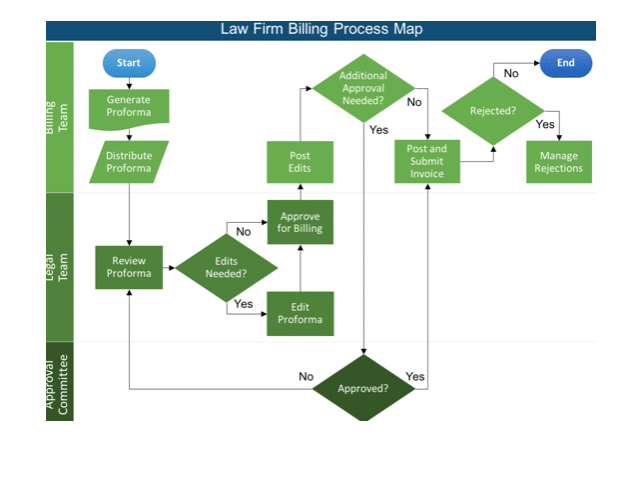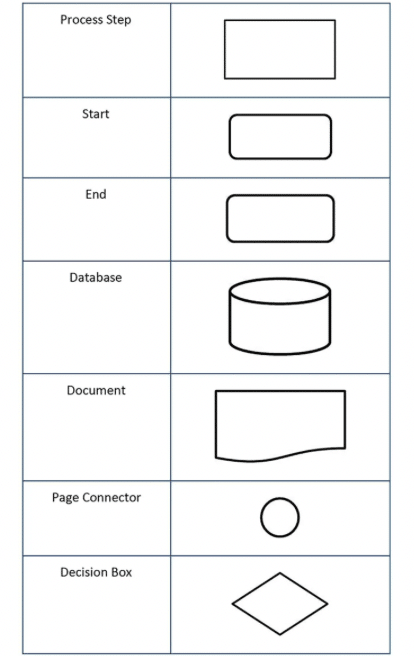
Mapping Out Your Legal Workflows
First, what are legal workflows?
The term ‘workflow’ refers to the process of completing a task and can be illustrated as a series of steps that explain the task actions from beginning to end.
What is an example of a ‘legal workflow’?
An example of a legal workflow is the process of briefing external counsel which routinely involve the law firm clearing potential conflicts before the client provides the full, detailed, and reviewable brief. Here, establishing a clear and structured workflow can be highly manual and time-consuming, especially if multiple law firms are involved and the client is conducting a competitive request for proposal (RFP) process. Add in multiple internal approval requirements – which are quite common across corporate and government legal departments – and the workflow complexities escalate. However, as we shall discuss further below, the in-house team can achieve effective process governance and control using process mapping and workflow automation.
Process mapping is a widely accepted practice in the broader business context as a common tool for improving efficiency and preventing loss when delivering a product. Legal departments, however, can be reticent to requests from vendors and corporate officers when asked to map their legal workflows. That friction comes from perceptions of legal process mapping as a burden on the already limited time of busy lawyers and general counsels. The frustration is understandable but also misses the mark on unpacking the true value of process mapping. Let us explain.
Key Takeaways
- The value of legal process mapping is visualizing all the steps of a project to identify weaknesses and make improvements.
- The more detailed you can make your legal process maps, the more value they will provide.
- Create standards, including periodic reviews, for developing and perfecting your legal process maps.
Why Process Mapping Is Not a Waste of Time for Legal Departments
Legal operations are inarguably different from other processes, like the production and delivery of a widget, because they involve a high degree of abstract, intellectual work. Sometimes that work results in a finished product, such as an executed contract, and other times it doesn’t (e.g., a simple email responding to a query from HR or sales).
This variance makes standards difficult to capture in a process map because you, as a lawyer, know the deliverable but also realize that facts and events will change your approach. A process map exists in a vacuum. The practice of law does not, and you know that better than anyone. However, legal process mapping is less about the direct benefit to you and your team and more about the indirect benefits from over-communicating and detailing workflows. In other words, you might think of the value as more like the famous line from Jerry Maguire. It’s about finding new ways to “Help me, help you.”
Legal process mapping forces you to visualize every stage of your work as well as the work of those you must engage in completing a project. The benefits can be surprising as you:
- Identify unnecessary or duplicative steps.
- Bridge knowledge gaps for other departments.
- Find ways to combine tasks and minimize exchanges.
- Discover the source of delays in projects.
- Locate potential risks in procedure (e.g., completing steps out of order or missing a critical level of review).
- Create guidance for when things get off track so you can correct course.
What Workflows Does Your Legal Department Need to Map?
To some degree, every legal operation in your department will be worth mapping because it creates a baseline for starting and finishing projects. However, the better question might be how granular should you go with your legal process mapping? You may think of most mapping as a way of showing the big picture, but you may find that more value comes from the most microscopic levels of mapping. You want to articulate clearly the scope of every stage in a process. For example, instead of saying, “send contract to sales team for review,” your map would benefit more from answering the following:
- Who in sales receives the contract? Identify a specific person or position.
- What is the purpose of the step?
- What does the sales team need to accomplish the step?
- Who is responsible for the items the sales team needs for the step?
- What signals completion of the step?

Common Legal Workflows Worth Mapping
The specific workflows and operations you map will depend on the structure and function of your legal department. Remember, it’s not just about what your team does internally but also the legal workflows you manage through external parties (e.g., specialty litigation). Some common use cases could include:
- Contract management
- eDiscovery and document review
- Due diligence or investigative work
- Compliance reporting and regulatory filing
- Corporate governance
- Administrative jobs like billing or legal spend

Helpful Tips for Legal Process Mapping
As you go about your legal process mapping, here are some considerations to make the most effective use of the experience:
- Have a uniform legend and standards to identify different parts of your map that you consistently apply across all maps (e.g., decision points, flows, beginnings, and ends).
- Create different maps for different types of matters within the same category. For example, your process is likely different for a lease contract versus a sale agreement or an employment litigation dispute versus a product liability defense.
- Make external maps that you can freely share with outside parties to improve collaboration.
- Share the legal process map with everyone involved to get critical feedback (e.g., paralegals, assistants, outside department contacts).
- Specifically reference the party responsible for a particular step, whether it’s a junior general counsel, legal operation specialist, contract manager, etc.
Video: An explanation of the value of legal process mapping.
Knowing When to Review and Revise Your Legal Process Maps
Legal departments are not static entities, and your processes are bound to change as core functions evolve, added compliance obligations arise, and new people enter the department. When significant changes occur, it’s important to see if the situation warrants a modification of your legal process maps. Some possible signals for a good time to review your maps could include:
- The use of new technology or another resource (e.g., outside counsel or an alternative legal service provider).
- When repeated errors take place.
- Any restructuring of your legal department (e.g., downsizing, increased hiring, shifting roles).
Outside of special circumstances, you may also consider incorporating reviews of your legal process maps into other standard review periods annually. Even if you don’t think your process changed, glancing at your map may spark a realization about how operations have shifted.
Exigent Wants to Help Your Legal Department Process Map Better and Faster
Exigent aids the busy and resource-constricted needs of GCs and their legal departments through various key legal operations. We believe in taking the time to understand a legal department by identifying its structure via legal process mapping and automation. By taking on the burden of this administrative task for our clients, we can offer customized solutions in contract management, eDiscovery, and a host of other workflows vital to a legal department’s success. Find out what makes us unique as an ALSP and schedule a consultation with our representatives today.
Also, visit our Organization, Automation and Workflow Management page to take your legal workflow project from idea to reality.
About the Author:
Exigent is an Alternative Legal Services Provider (ALSP) breaking industry boundaries and raising the bar for data-driven decision-making. With a powerful combination of technology, legal expertise, and business acumen, Exigent creates expert solutions that drive better legal and business outcomes for law firms and corporations.
Exigent delivers scale, expertise, and insights that generate bigger returns for CLM – Contract Lifecycle Management, Legal Spend Management, e-Billing, Due Diligence, Document Review, eDiscovery and Litigation Support, Commercial Services, Regulatory & Compliance, Outsourced Legal Administration, and Legal Tech Design.
Follow us on LinkedIn and Twitter to transform the way you do legal.
















